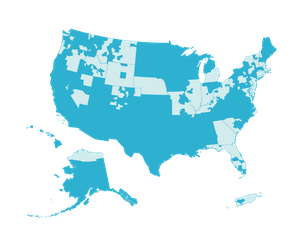On a post-hurricane assessment visit to Puerto Rico, LISC Rural program officer Anna Hurt learned that baseball fields around the island are more than just a place for a game, they are a vital resource that brings the neighborhood together and boosts local economies. Damage to community fields is still deeply felt throughout the island. In this blog, Anna shares the value of bringing sports and recreation into the disaster recovery discussion and the launch of Play Ball Again, a new initiative to revive 25 fields for 17,500 boys and girls across Puerto Rico. Last week, LISC celebrated the opening of two such fields, with support from Maestro Cares Foundation, Good Bunny Foundation, UNICEF USA, and Chicago Cubs Charities, and showed how communities like the one where Ana lives come together for the love of the game, and one another.
At my home in Puerto Rico, there is a baseball field literally at the end of the driveway. I have only to walk across the street and I am there. In the months I have lived there, I have seen first-hand what a small, neighborhood field means to a community. Teams practice there several times a week— sometimes small boys and girls (with every father out there on the field, too). Other times, older youth, under the instruction of a coach, running drills while their parents sit in the stands, wander over to the bakery across the way, or walk around our block for their own exercise until practice is over.
Last week, as I pulled around the corner, I saw a father and son out there, the father pitching him batting practice, pausing to talk after each swing. On Saturdays, often there are youth games from morning to early afternoon. On Sundays, adult softball tournaments. Sometimes I wander over on weekends to watch, talk to friends and neighbors and have a few drinks and some food.

All of this is worth writing because it demonstrates the most important piece of LISC’s Play Ball Again project: sports is community. It is fathers and sons. It is parents sharing news and information with each other because they see each other so regularly. It is the bakery getting a boost in sales several nights a week from foot traffic to the field and hungry team members. It is neighbors and friends stopping by a local tournament to spend time together. (It’s also the field where I crawl under the gate to get some swings in after a long day, but keep that on the down low). Those things are what make us part of community.
I first visited the island five months after Hurricanes Irma and Maria crossed Puerto Rico in 2017. I still vividly remember flying in and seeing the devastation as I made that first airborne pass to land I saw my first of many damaged baseball fields on that trip, when I visited one of our partners, All Hands and Hearts Smart Response in Yabucoa, an agricultural town on the eastern end of the island, many of whose residents were without power or running water for nearly a year after the hurricane. The dream of this program, Play Ball Again, was born in that moment: a perfect nexus of work, recovery, my passion for sports (especially baseball) and an island I fell in love with. Sports is not usually the first thing that comes up in disaster recovery discussion. In fact, it rarely does. But sports and the spaces where they are played are an important part of recovery.
Through sports and physical activity, youth and adults can create a new normal after a disaster. Sports provide the space for healthy activities and access to areas where people come together, and foster outlets for physical and mental health recovery.
Community spaces are vital parts of cities, towns and neighborhoods. Whether a museum, a public garden, or a baseball park – these spaces are part of the collective memory and soul of the people who live there. It is critical to rebuild them after a disaster and contribute to a community’s ability to retain those shared memories and sense of safety and strength.
Rebuilding a ballfield also grows other things in the community. It helps retain small businesses, like the bakery in my neighborhood, because players and their parents are back on the fields and out in the area throughout the week. It also provides an additional touchpoint for LISC and our local partners to reach the community and connect around larger recovery projects and needs specific to the community.
Sports is community. It is community at its very best. It is capable of bringing us together, uniting us, healing us in our most difficult moments.
For the love of the game. Let’s play ball … again.
ABOUT THE AUTHOR
Anna R. Hurt, Disaster Recovery and Resiliency Program Officer, Rural LISC
Anna R. Hurt is the Disaster Recovery and Resiliency Program Officer for Local Initiative Support Corporation’s Rural division. She is also the program officer overseeing Play Ball Again. She can be reached at ahurt@lisc.org
